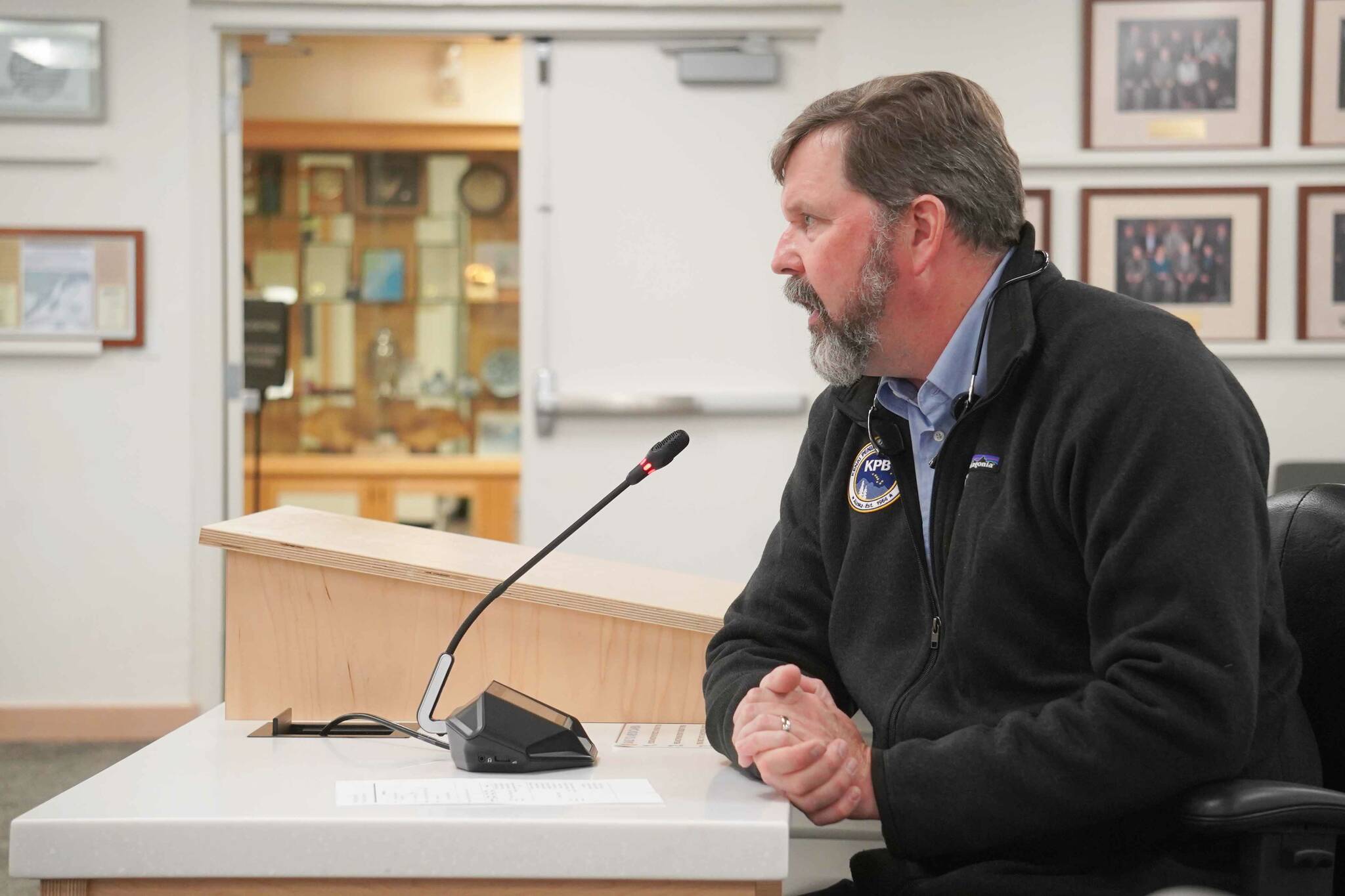Roughly two years after Kenai Peninsula Borough voters approved a $65.55 million bond package to address a list of 10 critical maintenance projects around the Kenai Peninsula Borough School District, the combined price tag has ballooned to $83.42 million, and borough administration says that the scope of some projects may need to be retooled.
That was the central takeaway during a work session of the Kenai Peninsula Borough Assembly where Borough Mayor Peter Micciche and Borough Purchasing & Contracting Director John Hedges gave a “status report” on each of the projects before discussing how the bond project can or will move forward.
Reconstruction of Soldotna Elementary School, the most expensive project on the list, was originally budgeted to cost $21.5 million. An educational specification, which Hedges likened to an architectural plan that describes the size and needs of the proposed new facility, currently describes a cost estimate of $35 million, he said.
“We’ve gone back to the drawing board, and we’ve tried to come up with some other solutions to close that budget or work through those same objectives at a cheaper cost.”
To that end, Hedges said, the borough is now finalizing a new request for proposals to bring on what Micciche called “a new set of eyes.” Hedges said that the borough plans to investigate “every option that we have” for housing Soldotna Elementary and other schools that were set to be rehomed under the bond package, like Soldotna Montessori, River City Academy and Connections Homeschool.
The update memo by Hedges says that an educational specification is intended for development later this year that would describe renovation of Soldotna Preparatory School to house Soldotna Elementary students. A move of KPBSD administration to that building, described in the original bond package, “has been rejected by KPB and removed from the project program,” the memo reads.
A project to improve student drop-off at multiple schools recently has changed hands to a new project manager, Hedges said, and that manager is now visiting schools and observing drop-off activities at schools each morning. The goal, Hedges said, is to define and understand the problems before developing a solution. Per his memo, work is intended to begin in the spring of next year.
Seward High School’s new field has been installed and is ready for use, while placement of the new track is dependent on weather conditions, Hedges said. The contractors are ready to complete the work, “if the weather will allow,” but completion could be pushed to the spring. A similar replacement project for the track and field at Nikiski Middle/High School also included in the bond project wasn’t mentioned.
There are several projects, Hedges said, that are designed and ready to be released or soon will be designed and ready to be released, but the borough perceives a shortage of contractors and so is waiting until next spring to move forward. These include roof replacements for Nikiski North Star Elementary and Hope School, improvements to the entrance of Homer High School, repair of the front facade siding of Soldotna High School — reduced in scope from repairs to the whole building — and renovation of Kenai Middle School’s layout to increase security.
“We think that contractors are busy,” Hedges said. “It’s not a buyer’s market right now.”
The new concessions stand at Kenai Central High School is nearing completion, waiting on “certain products,” and the contractor, Eberline Building, has committed to finishing by Dec. 6, Hedges said.
The final project on the list, construction of a new maintenance shop for KPBSD and the borough, is on hold while priority is given to more student-facing projects. Micciche went further in saying that it is “likely not going to happen.”
The rise in costs for the projects, Micciche said, are “significant.”
“It’s not possible to do the work as was originally intended,” he said. “That’s why it’s all hands on deck on getting together and finding some agreement on how we’re going to satisfy the need for the students.”
Borough Finance Director Brandi Harbaugh said that while there aren’t deadlines to spend the bond funding, if the borough hasn’t spent 85% of the total within three years, they will be required to return “excess arbitrage” to the Internal Revenue Service.
“No, we do not lose the bond, but if we don’t spend within three years, it just changes the ramifications associated with the arbitrage,” she said.
In regards to the legal requirements of the borough to follow through with the projects approved by voters, Borough Attorney Sean Kelley said that there is some flexibility in the definitions of words used like “reconstruction.”
Assembly Vice President Tyson Cox, who requested the update on the project from borough administration, said that he was eager to learn how the borough can move forward and accomplish projects that were approved by voters.
“We’re in a pickle,” he said.
Micciche, during the work session, several times said that the borough is “square-footage rich.” In completing a new evaluation of the projects, he said, they may be able to figure out how that space can be better utilized when “we can’t get there with a new Soldotna El.”
Questions that may be answered by that new exploration of the bond package, he said, are how best Soldotna Preparatory School’s 84,000 square feet can be used, how populations can be moved around if a new Soldotna Elementary had a much smaller footprint, how to meet the needs of students at Connections Homeschool, River City Academy and Soldotna Montessori, and others. The final look of the projects undertaken via the bond package, might be “somewhat different,” compared to how they originally were described.
“Our responsibility is the efficient spending of every dollar that we have available to us to meet the needs of the people of the Kenai Peninsula Borough, and in this case the students of the Kenai Peninsula Borough School District,” Micciche said.
A full recording of the work session will be available at kpb.legistar.com.

